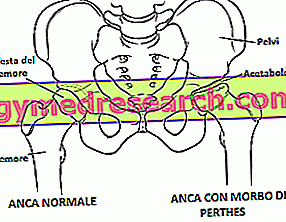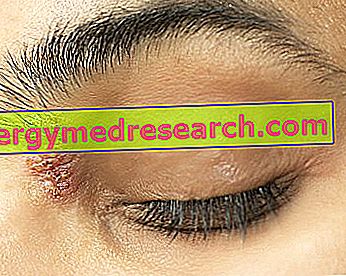Generality
Perthes' disease, also called Calvé-Legg-Perthes disease, is a disease typical of children, which affects the hip joint, particularly the femoral head.

Figure: anterior representation of the bony structures of the pelvis and of the hip joint of a male patient with Perthes' disease. Note the fracture of the left femoral head. From the site: tsrhc.org
The cause of the disease lies in the reduced flow of blood to the upper part of the femur (precisely called the head), which first encounters osteonecrosis and, subsequently, a fracture.
The symptoms of Perthes' disease consist of obvious lameness, pain in the hip and limited joint mobility.
For a correct diagnosis, physical examination and instrumental tests, such as X-rays or bone scintigraphy, are helpful.
Therapy depends on the age of the patients and the severity of the disease. In most cases, doctors resort to conservative treatments, while surgery is used only in certain circumstances.
Brief anatomical reference to the hip
The term hip identifies both the anatomical region of the human body that connects the pelvis to the thigh, and the articulation that allows this connection.
The hip joint (also called the coxofemoral joint or simply the hip) is composed of a skeletal scaffold held together by different muscles and ligaments. The bones that make it up are:
- The root (or proximal part) of the femur, composed of the underlying head and neck
- The acetabulum, a cavity of the iliac bone (or hip bone) in which the femoral head is positioned

The hip is one of the largest joints in the human body and belongs to the enarthritis family. In arthrosis, a convex bone portion is housed in a concave bone portion; this structure, together with the ligaments that surround it, allows a wide mobility, superior to that of the other types of articulation.
To reduce friction and impact shocks, the hip joint is surrounded by synovial fluid and cartilage . Without it, the bony surfaces would deteriorate due to the continuous rubbing between them.
The hip is fundamental, since it allows the man to assume the standing position, to walk, to run etc.
What is Perthes' disease?
Perthes' disease is a typical childhood disease characterized by an interruption of blood flow to the head of the femur. This interruption causes the head of the femur to meet, first, a weakening and then a break.
As in normal bone fractures, a fracture of the femoral head is followed by a welding process; however this welding is only temporary, since the interruption of the blood flow and the subsequent weakening of the bone tend to recur. So, in other words, those who suffer from Perthes' disease are subject to periodic ruptures of the femoral head.
Perthes' disease is also known as Calvé-Legg-Perthes disease and belongs to the aseptic necrosis of the bone: necrosis because it is associated with premature death of bone cells, aseptic because this process is not infectious.
HOW LONG IS THE DEAD OF PERTHES?
Fractures (and subsequent welds) of the femoral head can be repeated for some time, even for two or more years .
Epidemiology
According to Anglo-Saxon research, in the United Kingdom, Perthes' disease affects one child every 1, 200.
Although it can occur at any age of childhood, it is more common between the ages of 4 and 8.
The individuals who suffer most from it are the male subjects: the male / female ratio, in fact, was around 4: 1.
ORIGIN OF THE NAME
The Calvé-Legg-Perthes disease owes its name to the orthopedic surgeons Jacques Calvé, Arthur Legg and Georg Perthes, who were the first to describe the disease in 1910.
Causes
In Perthes' disease, the weakening and rupture of the femoral head is caused by an interruption of blood flow directed to this same bone portion. In fact, deprived of normal blood circulation, the bones slowly encounter a process of death, known as osteonecrosis .
But what stops the flow of blood to the femoral head and why does this occur during childhood?
Unfortunately, doctors and scientists have not yet managed to clarify these question marks; therefore the precise causes that determine Perthes' disease are unknown (idiopathic osteonecrosis).
At the time of the first description of Perthes' disease, Calvé hypothesized that the disease was linked to scoliosis, while Perthes thought it was the consequence of an infection capable of causing a form of degenerative arthritis .
RISK FACTORS
The risk factors that characterize Perthes' disease are the following:
- Age between 4 and 8 years
- Male sex
- Caucasian race. Researchers have noted that white-skinned individuals are more affected than those with black skin.
- Family history. Sometimes, Perthes' disease occurs in several members of the same family. This would seem to be related to a certain genetic predisposition to the disease.
Symptoms and Complications
In general, the pathological manifestations related to Perthes' disease tend to appear gradually. The typical symptoms and signs consist of:
- Lameness . It is the most characteristic sign; initially it is hardly mentioned, but, within a few weeks, lameness becomes a very obvious problem.
- Sense of pain and stiffness at the affected hip and adjacent groin . Sometimes, pain and stiffness also extend to the entire leg (including the knee joint).
- Reduced joint mobility of the hip
- Weakening and hypotrophy of the affected lower limb muscles . The bone fracture of the femoral head requires the patient to rest at absolute rest. With forced immobility, unused muscles reduce their volume (hypotrophy).
The hypotrophy emerges from the comparison between the lower limb and the healthy limb.
- Shortening of the affected lower limb . Repeated fractures make the affected lower limb slightly shorter than the healthy one.
IS THE DEAD OF PERTHES UNILATERAL?
Perthes' disease is usually one-sided (that is to say on a hip only). However, in some rare circumstances, it can affect both hips ( bilateral ).
According to some studies carried out in the United Kingdom, only one case of Perthes' disease per 6 is bilateral (NB: the involvement of the two joints can also occur at different times).
OTHER CLINICAL CHARACTERISTICS
It is possible that the patient, in addition to the related hip and lower limb problems, also present: hyperactivity, stature below average, delayed bone age and congenital anomalies of various types.
Since doctors believe that these clinical features are somehow linked to Perthes' disease, in these situations they tend to consider the disease a sort of syndrome (NB: in medicine, the term syndrome identifies a set of clinical symptoms and signs that characterize one or more morbid states).
WHEN TO REFER TO THE DOCTOR?
If a child limps without an apparent reason and complains of pain in the hip, it is advisable to immediately contact the treating doctor, for a consultation and a deepening of the situation.
COMPLICATIONS
Sometimes, the bone welding process can occur incorrectly. This causes the femoral head to assume, in a permanent way, an abnormal conformation - generally losing its natural roundness - and that it no longer fits perfectly with the acetabulum.
The appearance of such alteration could make hip replacement necessary in adulthood .
Who is most at risk of permanent hip changes?
From statistical research, it was found that children with Perthes' disease and age over 6 are more likely to develop permanent joint problems.
Diagnosis
To diagnose Perthes' disease, doctors first use a thorough physical examination, and secondly, more specific instrumental tests, such as X-rays, nuclear magnetic resonance and bone scintigraphy . The latter are fundamental to visualize, in detail, the state of the hip joint.
Physical examination
During the physical examination, the doctor analyzes the symptoms and tests the mobility of the hip.
The verification of joint mobility is very important from the diagnostic point of view, since, in the presence of Perthes' disease, some movements are impossible (or in any case strongly painful).
Treatment

Figure: X-ray of a hip (to the right of the reader) affected by Perthes' disease.
In cases of Perthes' disease, the goal of therapy is to promote the correct bone welding of the femoral head, to avoid unpleasant consequences in adulthood.
The choice of the most appropriate treatments for this purpose basically depends on two factors:
- Age of the patient
- Severity of the disease
Generally, in front of patients under the age of 6-7 years, doctors resort to conservative remedies and recommend rest. Faced, instead, with patients over 6-7 years of age or with very serious cases, they also tend to use surgery, since, in the absence of surgery, the probability of a permanent modification of the femoral head would be higher. or of the whole articulation.
CONSERVATIVE CARE AND REST
Conservative treatments allow to alleviate the symptoms and reduce the risk of unpleasant future consequences.
The main conservative treatments consist of:
- Physiotherapy . Physiotherapy involves stretching and stretching exercises . These serve to maintain muscle tone and stabilize the position of the femoral head in the acetabulum.
Some orthopedic doctors and some physiatrists recommend swimming (except in conditions that make it impossible or contraindicated).
- Crutches . In the most acute periods of the disease, the use of crutches is often recommended, useful for reducing the load (and therefore also the pain) to damage the hip.
- Traction of the lower limb in pain .
- Special plaster or guardian, to keep the femoral head in the correct position.
- Painkillers . Painkillers, such as ibuprofen and paracetamol, are recommended when the pain is particularly intense.
- Application of ice on the aching hip.

Figure: Casting (left) and guardian (right), indicated for Perthes' disease.
In addition to the aforementioned treatments, it is essential, especially in the most serious phases of the disease, to observe a period of absolute rest .
SURGERY
Surgeries aimed at restoring or maintaining the right hip structure are different. The various procedures that can be implemented include:
- Articular realignment, after surgical incision of the femur.
- Surgical elongation of tendon structures that reside near the hip (NB: these, in fact, are very often "contracted" due to the disease)
- Surgical removal of osteo-cartilaginous irregularities formed on the femoral head.
The practice of such interventions reduces the risk of future complications and of having to resort, in adulthood, to hip replacement surgery.
Prognosis
In most cases, Perthes' disease has a positive prognosis and does not affect joint mobility (even in the future) of the sick child.
Despite this, the disease should not be underestimated, because - as has already been widely discussed - Perthes' disease can permanently alter the hip joint.



